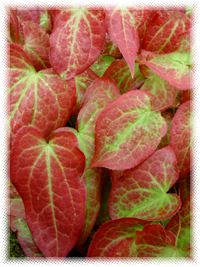Epimedium Epimedium grandiflorum

- Common Names
- Epimedium , horny goat weed, xian ling pi, and yin yang huo
- Botanical Name
- Epimedium grandiflorum
- Family
- BERBERIDACEAE
Medicinal Uses & Benefits of Epimedium
![]() How to Use|
Side Effects |
Plant & Garden|
Folklore
How to Use|
Side Effects |
Plant & Garden|
Folklore
- Medicinal Uses: * Aphrodisiac
* Asthma
* Bronchitis
* Cardiovascular
* Chinese
* Libido
* Longevity Tonics
* Menopause
- Properties: * Aphrodisiac * Diuretic * Hypertensive * Tonic
- Parts Used: Leaf Extract
- Constituents: fats, saponins, and essential oil, with trace amounts of epimedins, epimedosides, icariin, magnflorin, and quercetin
How to Use: Epimedium

The name "Horny goat weed" is based
on a colorful Chinese legend
Epimedium, also known as Yin Yang Huo or Horny Goat Weed, is a powerful remedy in Traditional Chinese Medicine and has been used for thousands of years to promote male potency, libido, and as an aphrodisiac. Modern Chinese herbal medicine uses epimedium (usually in combination with other herbs) not just to treat impotence, but also for asthma, bronchitis, cervical dysphasia, congestive heart failure, leucorrhoea, leukopenia, and viral infections of the heart. 1
Epimedium is used to treat menopause in women often combined with Morinda. It is officially listed by the Chinese Academy of Medial Sciences as one of an elite group of herbs that slow down aging and promote longevity. Perhaps even more important have been the recent discoveries that Epimedium has powerful immune-modulating activity. 2
Preparation Methods & Dosage :Teas, tinctures, encapsulations
Traditional Chinese Medicine
 TCM practitioners use this herb used to increase the Yang energies, for instance, it would be used to enhance male sexual performance. Recent research has confirmed that Yin Yang Huo can increase sperm production and stimulate sexual desire.
TCM practitioners use this herb used to increase the Yang energies, for instance, it would be used to enhance male sexual performance. Recent research has confirmed that Yin Yang Huo can increase sperm production and stimulate sexual desire.
Epimedium Side Effects: Do not exceed recommended dose. Overdoses can cause rapid heart rate, and high blood pressure.
Plant Description

Epimedium grandiflorum Violaceum
- Plant Class: Pereinnial ivy-like ground shrub, It is in the same plant family as barberry and Oregon grape root
- Etymology: The genus was named epimedium because it is similar to a plant found in the ancient Asian kingdom of Media, now a part of Iran. Epimedium is a genus of many related plant species and some are used for medicinal purposes, including Epimedium sagittatum, Epimedium brevicornum, epimedium grandiflorum, and Epimedium koreanum
- Flowers/Fruit/Seeds: Depending on the variety flowers can be yellow, pink or violet and white, and are born on along erect, branching stems flower with flowers hanging downward, resembling columbines
- Parts used: Dried Leaf
- Leaves: Leaves are medium green, young leaves may be bronze tinted in the spring
- Flowering Season:Spring
- Distribution: Native to higher and drier areas of China and Tibet, North Korea and Japan. The genus is also a popular ground cover for landscaping.
Regional Traditions :Traditional Chinese Medicine *
History and Traditions & Folklore
The name of the herb in Mandarin, yin yang huo, roughly corresponds to "weed for licentious goat." Legend has it that a goat herder discovered the properties of epimedium by observing his billy goats uncontrollable sexual appetites after they grazed on the herb.
- Mountain Rose Herbs
- Ron Teeguarden. "The Ancient Wisdom of the Chinese Tonic Herbs", Grand Central, (Mar 1, 2000)











